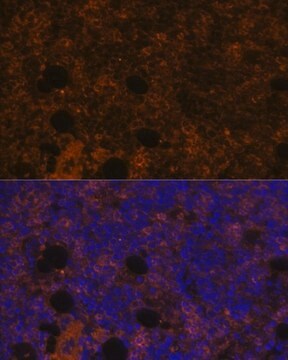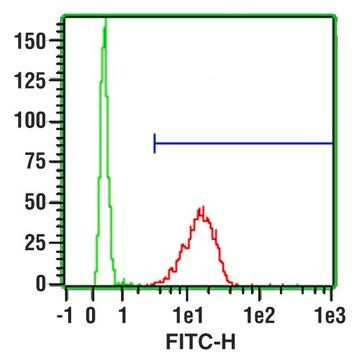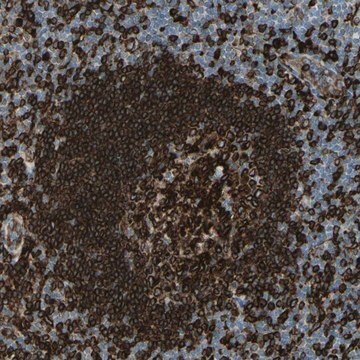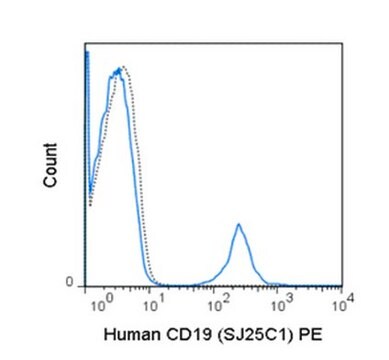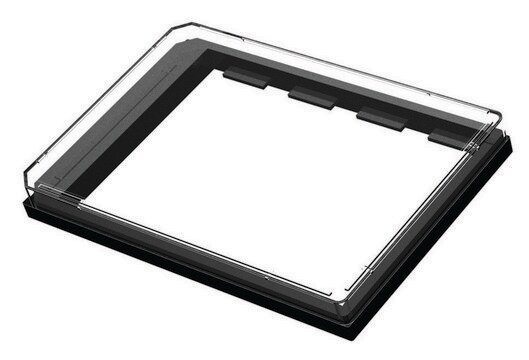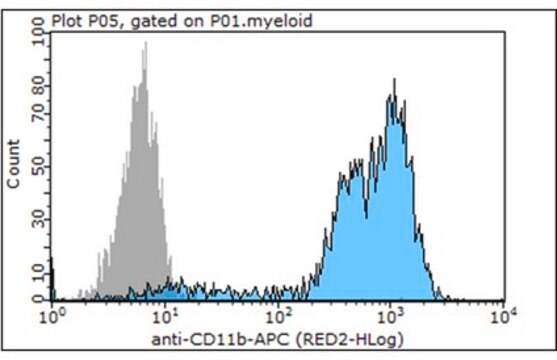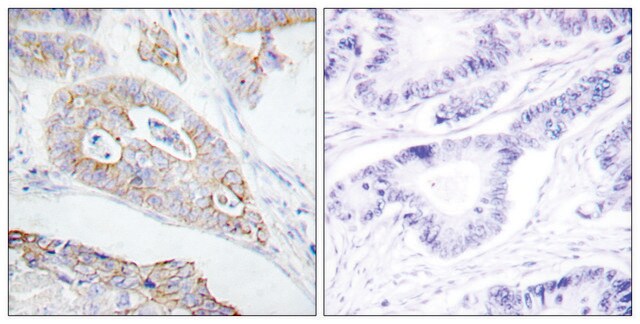SAB4700101
Monoclonal Anti-CD14-PE antibody produced in mouse
clone MEM-15, purified immunoglobulin, buffered aqueous solution
Synonym(s):
Anti-LPS-receptor
Sign Into View Organizational & Contract Pricing
All Photos(1)
About This Item
UNSPSC Code:
12352203
NACRES:
NA.44
Recommended Products
biological source
mouse
Quality Level
conjugate
phycoerythrin (R-PE) conjugate
antibody form
purified immunoglobulin
antibody product type
primary antibodies
clone
MEM-15, monoclonal
form
buffered aqueous solution
species reactivity
nonhuman primates, human
technique(s)
flow cytometry: suitable
isotype
IgG1
NCBI accession no.
UniProt accession no.
shipped in
wet ice
storage temp.
2-8°C
target post-translational modification
unmodified
Gene Information
human ... CD14(929)
General description
CD14 (cluster of differentiation 14) is a myelomonocytic differentiation antigen, encoded by the gene mapped to human chromosome 5q23-31. It is mainly expressed by monocytes, macrophages and activated granulocytes.
Immunogen
A crude mixture of human urinary proteins precipitated by ammonium sulphate from the urine of a patient suffering from proteinuria
Application
The reagent is designed for Flow Cytometry analysis of human blood cells using 20 μL reagent / 100 μL of whole blood or 1e6 cells in a suspension. The content of a vial (2 mL) is sufficient for 100 tests.
Biochem/physiol Actions
CD14 (cluster of differentiation 14) serves as an important receptor of bacterial lipopolysaccharide (LPS). CD14 and LPs complex interacts with toll-like receptor 4 and enhances the expression of inflammatory mediators, including tumor necrosis factor (TNF)- and interleukin (IL)-1, via p38 mitogen-activated protein kinase and nuclear factor-B pathway. Mutation in the gene is associated with the development of myeloid leukemias and generalized chronic periodontitis (GCP).
Features and Benefits
Evaluate our antibodies with complete peace of mind. If the antibody does not perform in your application, we will issue a full credit or replacement antibody. Learn more.
Physical form
Solution in phosphate buffered saline containing 15 mM sodium azide and 0.2% high-grade protease free BSA as a stabilizing agent.
Disclaimer
Unless otherwise stated in our catalog or other company documentation accompanying the product(s), our products are intended for research use only and are not to be used for any other purpose, which includes but is not limited to, unauthorized commercial uses, in vitro diagnostic uses, ex vivo or in vivo therapeutic uses or any type of consumption or application to humans or animals.
Not finding the right product?
Try our Product Selector Tool.
Storage Class Code
10 - Combustible liquids
WGK
WGK 2
Flash Point(F)
Not applicable
Flash Point(C)
Not applicable
Choose from one of the most recent versions:
Already Own This Product?
Find documentation for the products that you have recently purchased in the Document Library.
Synergistic contribution of CD14 and HLA loci
in the susceptibility to Buerger disease
Chen Z
Human Genetics, 122, 367-372 (2007)
The CD14 monocyte differentiation antigen maps to a region encoding growth factors and receptors.
Goyert SM
Science, 239, 497-500 (1988)
Cytogenetic and molecular delineation of the smallest commonly
deleted region of chromosome 5 in malignant myeloid diseases
Le Beau MM
Proceedings of the National Academy of Sciences of the USA, 90, 5484-5488 (1993)
Dilshi Ishaan et al.
Genetic testing and molecular biomarkers, 21(9), 560-564 (2017-08-23)
The genetic variation in the CD14 rs2569190 promoter region contributes to the susceptibility of developing periodontitis. Since, CD14 gene polymorphism studies among various ethnic populations have produced conflicting results, the present study was designed to unearth the association between the
D P Funda et al.
Infection and immunity, 69(6), 3772-3781 (2001-05-12)
Human endothelial as well as epithelial cells were shown to respond to lipopolysaccharides (LPSs). However, the expression and release of CD14 by these so-called CD14-negative cells have not been studied in detail. We investigated three human intestinal epithelial cell lines
Our team of scientists has experience in all areas of research including Life Science, Material Science, Chemical Synthesis, Chromatography, Analytical and many others.
Contact Technical Service